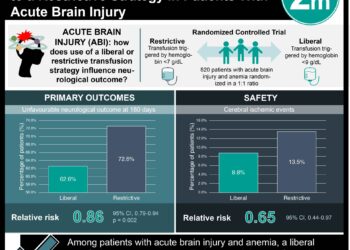APOEε4 genotype may increase risk of chronic traumatic encephalopathy following repetitive head impact
1. A cross sectional study of postmortem brain specimens from individuals with a history of repetitive head impact found that individuals with the APOEε4 genotype were often burdened with a greater load of tau protein across several brain regions.
2. The encephalopathy in APOEε4 genotyped individuals was akin to that of someone who had played American football for approximately 7 years.
Evidence rating level: 2 (Good)
Study Rundown: Chronic traumatic encephalopathy (CTE) is a neurodegenerative disease characterized by deposits of hyperphosphorylated tau protein found perivascularly, usually deep within the brain sulci. CTE is associated with a history of repetitive head trauma, often in the context of contact sports such as American football or boxing. The APOEε4 gene codes for a cholesterol transporter in the brain and is known to increase risk of other neurodegenerative diseases such as Alzheimer’s, while the APOEε2 genotype is protective. In this study, the relationship between CTE related to repetitive head injury (RHI) and APOEε4 genotype was investigated. A total of 364 donors with a history of RTI were included. Of these, 294 donors (80.8%) had neuropathologically-confirmed CTE. The overall allele frequency of the APOEε4 gene was 0.20 and was 0.06 for the APOEε2 gene. This study found that there were significant interactions between the APOEε4 gene and CTE stage as well as quantitative tau protein burden amongst donors over the age of 65. There was also a correlation between the APOEε4 genotype and dementia although the association was not statistically significant. Interestingly, none of these associations were significant in donors younger than 65 years of age. Finally, the study found that older (>65 years) individuals with the APOEε4 genotype had CTE levels comparable to having played football for approximately 7 years. In this study, Atherton et al demonstrate the burden of cognitive damage which may result from the APOEε4 genotype as a modifier of the risk of repetitive head injury. This information is clinically relevant because it further underscores the importance of head safety in sports by illustrating the repercussions later in life. Furthermore, the significant influence of older age provides further insight as to the pathogenesis of neurodegenerative disorders such as dementia and may pave the way for further studies of therapeutic options. A major limitation to this study was the cross-sectional study design and reliance on retrospective data from a melange of sources which could have introduced misclassification bias. However, the rigorous data analysis and correlation of neuropathological findings with clinical outcomes strengthens the conclusions made in this study.
Click here to read this study in JAMA Neurology
Relevant reading: Traumatic brain injury (TBI) in collision sports: possible mechanisms of transformation into chronic traumatic encephalopathy (CTE)
In-Depth [cross sectional study]: A cross-sectional study was performed using donated brain specimens from the Veterans Affairs-Boston University Concussion Legacy Foundation Brain Bank. Eligible donors were Black or White men who had a history of RHI (i.e., defined as having played contact sports or done military service). DNA samples were extracted and sequenced to identify donors’ APOE genotype. Other relevant demographic, historical data and neuropathological data were gathered by a blinded team of researchers and pathologists. Of the 294 individuals with CTE, 14.3% had Stage I pathology, 21.4% had Stage II, 32.7% had Stage III and 31.6% had Stage IV CTE. Amongst donors older than 65 years, the odds of increased CTE stage by a single level amongst individuals with the APOEε4 genotype was 2.34 (95% confidence interval 1.30 to 4.20). The APOEε4 genotype was also associated with burden of tau protein as measured by an increase in the AT8+ pixel count by 1.39 units (95% confidence interval 0.83 to 1.94). Finally, the odds ratio between APOEε4 genotype and dementia was 2.64 (95% confidence interval 1.06-6.61). In a sensitivity analysis excluding individuals who had been diagnosed with Alzheimer’s disease in life, the magnitude of association between RTI exposure and CTE stage was greater than the overall cohort. The association with dementia diagnosis was similar, and the association with tau protein load was decreased in comparison to the general analysis.
Image: PD
©2022 2 Minute Medicine, Inc. All rights reserved. No works may be reproduced without expressed written consent from 2 Minute Medicine, Inc. Inquire about licensing here. No article should be construed as medical advice and is not intended as such by the authors or by 2 Minute Medicine, Inc.






![The ABCD2 score: Risk of stroke after Transient Ischemic Attack (TIA) [Classics Series]](https://www.2minutemedicine.com/wp-content/uploads/2013/05/web-cover-classics-with-logo-medicine-BW-small-jpg-75x75.jpg)
